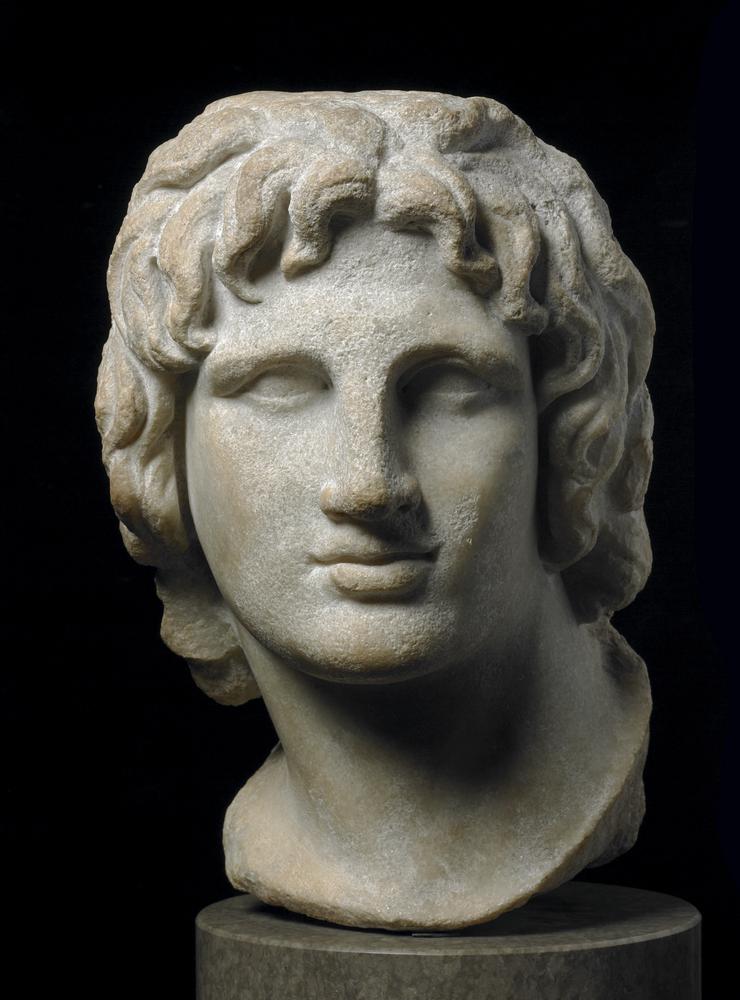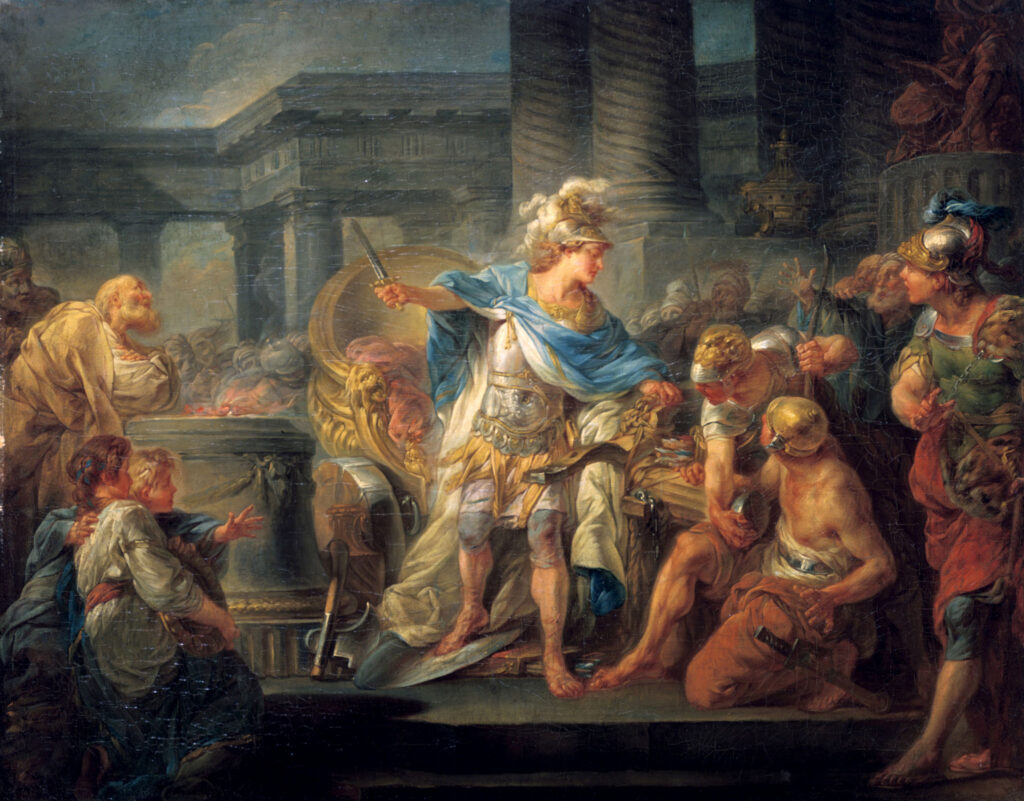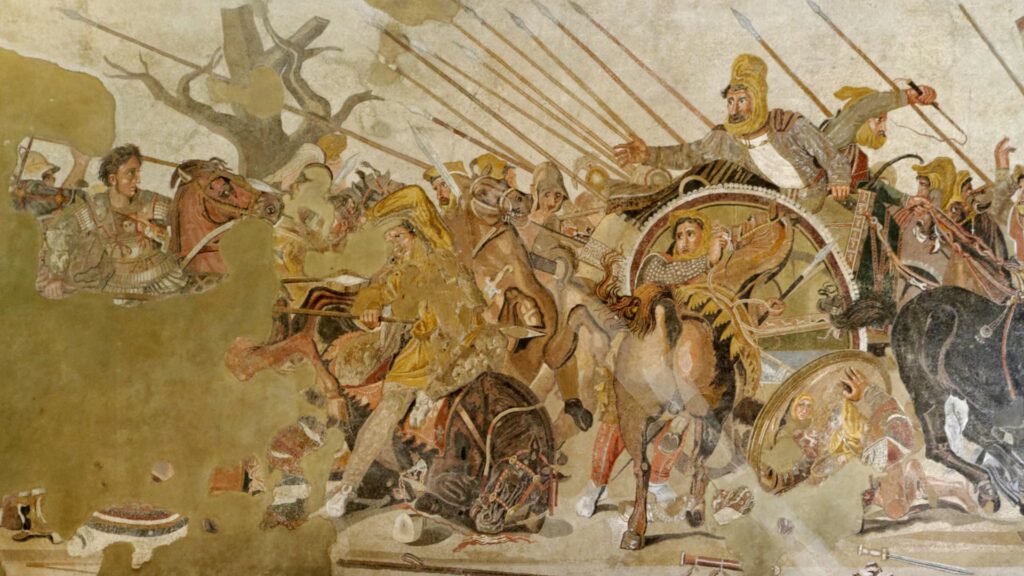Origins in Pella: The Forge of a Conqueror
Pella in 356 BCE was less a glittering capital than a frontier garrison town—a place where the scent of wet wool and forge smoke hung heavier than philosophical discourse. Nestled between marshlands and the Axios River, Macedonia’s powerbase operated like a military compound. King Philip II, a tactician who’d survived an arrow through the eye, drilled infantry in courtyards paved with crushed limestone. His innovations were brutally pragmatic: sarissas (18‑foot pikes) that outreached Greek spears, and phalanxes that rotated like “hinged doors” (as Polybius noted) to outflank enemies.
Queen Olympias, a devotee of Dionysian snake cults, wove Homeric ambition into her son’s psyche. She claimed Zeus fathered Alexander, a tale the boy embraced—not as myth, but political branding. His education balanced brutality and brilliance:
- Leonidas (relative of Olympias) made him march barefoot in snow and sleep on hard ground, once burning the prince’s treasured copy of the Iliad to teach detachment.
- Aristotle arrived when Alexander was 13, tutoring him under Mieza’s plane trees. Lessons were conquest‑ready: botany for healing wounds, meteorology for campaign seasons, ethics to justify “civilizing” barbarians.
The taming of Bucephalus reveals Alexander’s signature blend of observation and audacity. Plutarch recounts how 12‑year‑old Alexander noticed the stallion feared its shadow. By turning the horse sunward, he exploited equine psychology—not divine insight. The Thessalian breeder sold Bucephalus for 13 talents (a warhorse’s weight in silver), and Philip reportedly wept: My boy, seek a kingdom equal to yourself. Macedonia is too small.

From Prince to Commander: Blood and Iron Diplomacy
Philip’s assassination in 336 BCE at his daughter’s wedding was a masterclass in Macedonian court intrigue. The killer, Pausanias—a disgruntled bodyguard—may have been spurred by Olympias or by Persian gold. Alexander moved with chilling efficiency:
- Purges: Executed rival princes Amyntas and Caranus, plus Lyncestian aristocrats accused of treason.
- Symbolic Terror: Razed Thebes after rebellion, sparing only temples and Pindar’s house.
- Theatre of Unity: At Corinth, secured the League’s generalship by brandishing Persian threats while quietly bribing delegates.
The young king inherited 10 000 veteran infantry, 3 000 Companion Cavalry, and 500 talents—barely six months’ payroll. His genius lay in leveraging debt and momentum: mercenaries followed him chasing Persian treasure, while Greek cities funded ships lest they become another Thebes
.
Crossing into Asia: The Spear‑Cast Heard Round the World
Alexander’s 334 BCE landing at the Hellespont was pure theatre: he hurled a spear into Asian soil, proclaiming “spear‑won land,” then paid homage at Troy, reenacting Achilles’ funeral games. The Battle of the Granicus followed:
- Persian cavalry massed on the riverbank, expecting Macedonian infantry first.
- Alexander led his Companion Cavalry straight through the current at the command group.
- A scimitar sheared his helmet crest, but Cleitus the Black killed the attacker before the fatal blow.
Topographical studies show he used a hidden sandbar to avoid deeper channels. Asia Minor’s Greek cities then expelled Persian garrisons without resistance.
The Gordian Knot: Propaganda Forged in Steel
In 333 BCE at Gordium, Alexander met the legendary knot. Plutarch says he sliced it with his kopis, declaring, It doesn’t matter how it’s undone!
Evidence suggests premeditation:
- Timing: Arrived during local elections—built‑in witnesses.
- Iconography: The kopis symbolised Macedonian cavalry prowess.
- Media: Coins soon depicted Zeus with a sword—divine endorsement in silver.

King of Asia: Gaugamela’s Calculated Gambles
At Gaugamela in 331 BCE, Darius III fielded elephants, scythed chariots, and perhaps 100 000 men. Alexander inverted that strength:
- Oblique March: Advanced diagonally, stretching Persia’s line.
- Cavalry Feint: Companions pulled Persian horsemen off‑centre.
- Hammer Blow: A phalanx wedge drove at Darius’s gilt chariot.
Babylonian diaries record Darius fleeing toward Ecbatana. Alexander claimed 180 000 talents of silver and, more importantly, the title “King of Asia” at Babylon’s Esagila temple.
Farther Than Homer Dreamed: The Cost of “Glory”
After torching Persepolis to signal regime overthrow, Alexander drove into Bactria and Sogdia (329–327 BCE):
- Cultural Fusion: Married Roxana and staged mass Macedonian‑Persian weddings.
- Brutal Suppression: Crucified 2 000 rebels at the Sogdian Rock after cliff assaults using tent pegs as pitons.
The Hydaspes clash (326 BCE) against King Porus proved his tactical range: monsoon mud crippled cavalry, so Macedonian skirmishers blinded elephants to unleash friendly trample chaos. Porus, wounded seven times, became a loyal vassal.
But at the Hyphasis River the army mutinied. Despite three days of sacrifices, omens were “unfavourable.” The retreat through Gedrosia’s desert cost 12 000 lives, birthing myths of gold‑digging ants and mermaids.

Death in Babylon: Malaria, Not Treachery
In June 323 BCE Alexander collapsed after a banquet in Nebuchadnezzar’s palace. Royal diaries detail fever, abdominal pain, and paralysis over 11 days. Modern medicine points to typhoid or malaria; toxins fail the symptom test. Delay in corpse decay—likely Babylon’s arid heat—sparked rumours of divinity. Ptolemy diverted the funeral cortege to Alexandria, enshrining the body as dynastic talisman.
Legend vs. Reality: Forensic History
| Claim | Fact Check | Primary Source |
|---|---|---|
| “Undefeated in battle” | True in pitched battles; siege failures at Halicarnassus & Multan | Diodorus Siculus |
| “Wept for more worlds” | Fabricated; appears first in Cicero’s Tusculan Disputations | Plutarch refutes |
| “Believed he was a god” | Publicly encouraged cults; privately sceptical | Arrian, Anabasis |
| “Poisoned by Antipater” | Debunked by 2014 toxicology study; symptoms mismatch | Clinical Toxicology |
Why Alexander Still Matters: The Fractal Legacy
Alexander’s empire birthed the Hellenistic Koine—a Greek lingua franca knitting Egypt to India. It enabled:
- Science: Babylonian star charts and Greek geometry met in Alexandria’s Library.
- Religion: Gandharan Buddhas donned Greek himations; Zeus fused with Egyptian Amun.
- Imperial Templates: Rome copied his satrap system; Julius Caesar wept beneath his bust.
Historian Paul Cartledge writes, “Alexander mirrors our era—leaders weaponise story; truth bends to power.” From Napoleon to modern strongmen, those chasing “spear‑won land” still invoke his name.
Sources & Suggested Reading
- Arrian, Anabasis Alexandri (c. 150 CE)
- Fredrick, R. Gordium: The Forgotten Capital (2021)
- Cartledge, P. Alexander the Great: The Hunt for a New Past (2004)
- Olbrycht, M. “Macedonia and Persia” (Brill, 2021)
